The Contribution of Interference Control for Young Children's Working Memory Performance: Insights from Eye-Tracking
Abstract
:Introduction
Method
Participants
Procedure
Apparatus
Tasks

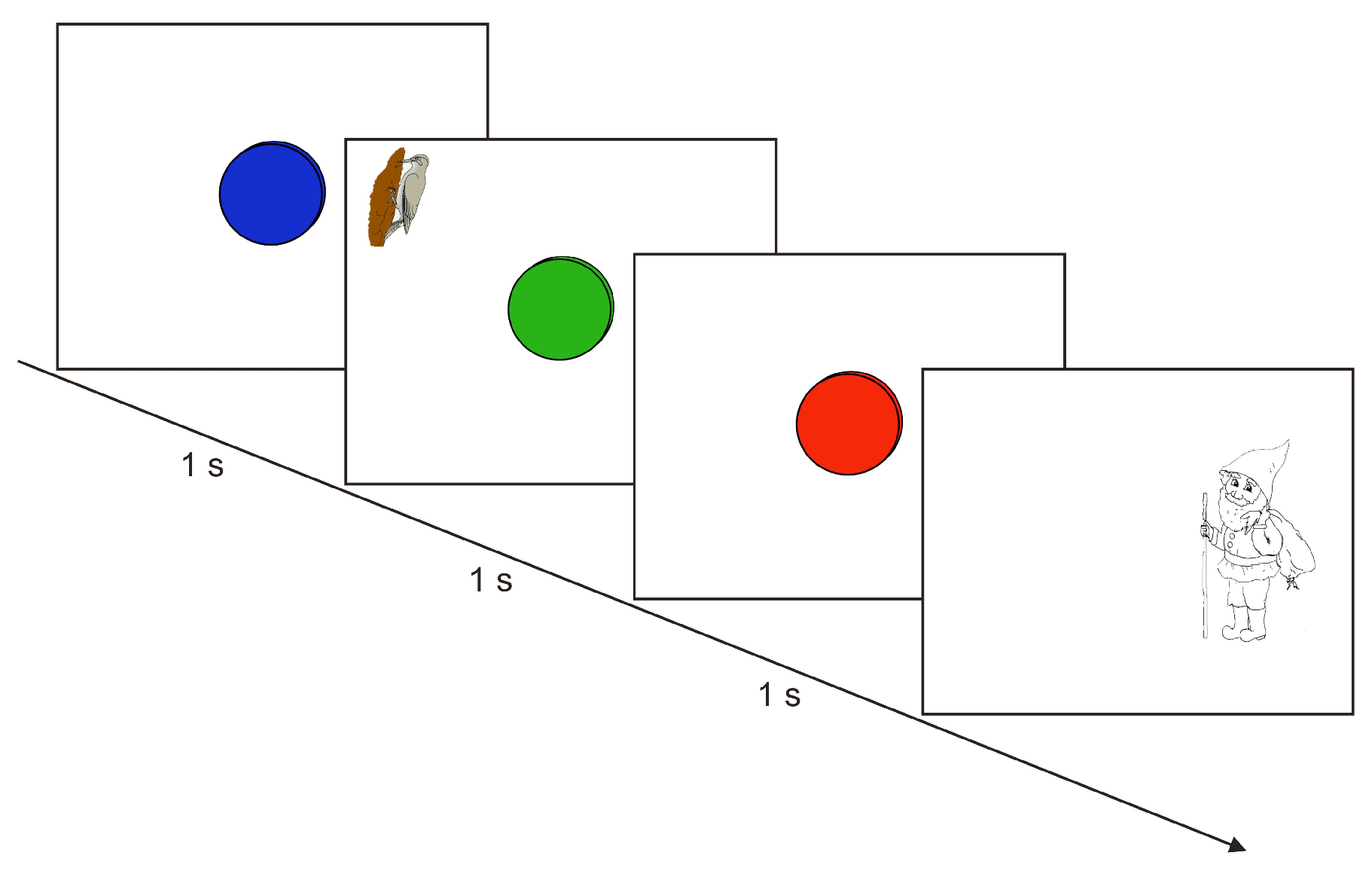
Results
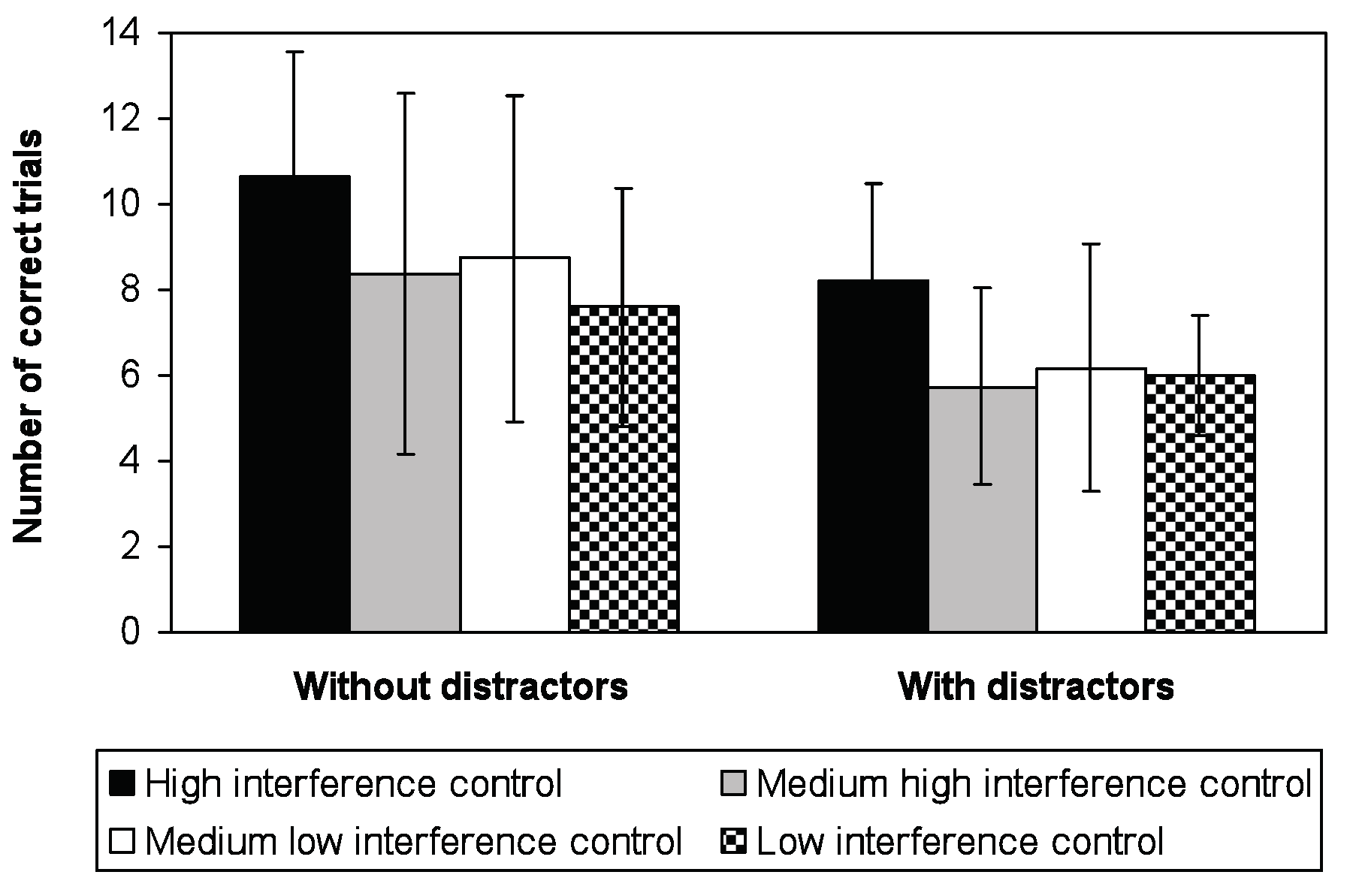
Discussion
Acknowledgments
References
- Alloway, T. P. 2007. Working memory, reading, and mathematical skills in children with developmental coordination disorder. Journal of Experimental Child Psychology 96: 20–36. [Google Scholar]
- Alloway, T. P., S. E. Gathercole, C. Willis, and A.-M. Adams. 2004. A structural analysis of working memory and related cognitive skills in young children. Journal of Experimental Child Psychology 87: 85–106. [Google Scholar] [PubMed]
- Awh, E., and J. Jonides. 2001. Overlapping mechanisms of attention and working memory. Trends in Cognitive Sciences 5: 119–126. [Google Scholar] [PubMed]
- Baddeley, A. D. 2001. Is working memory still working? American Psychologist 56: 851–864. [Google Scholar]
- Bayliss, D. M., C. Jarrold, D. M. Gunn, and A. D. Baddeley. 2003. The complexities of complex span: Explaining individual differences in working memory in children and adults. Journal of Experimental Psychology: General 132: 71–92. [Google Scholar] [PubMed]
- Best, J. R., P. H. Miller, and L. L. Jones. 2009. Executive functions after age 5: Changes and correlates. Developmental Review 29: 180–200. [Google Scholar]
- Bull, R., R. S. Johnston, and J. A. Roy. 1999. Exploring the roles of the visual-spatial sketch pad and central executive in children's arithmetical skills: Views from cognition and developmental neuropsychology. Developmental Neuropsychology 15: 421–442. [Google Scholar]
- Bjorklund, D. F. 2005. Children’s thinking: Cognitive development and individual differences, 4th ed. Belmont, CA: Thomson Learning, Inc. [Google Scholar]
- Cowan, N. 2005. Working memory capacity. Hove, East Sussex, UK: Psychology Press. [Google Scholar]
- Cowan, N., and T. Alloway. 2009. Development of Working Memory In Childhood. In The development of memory in infancy and childhood. Edited by M.L. Courage and N. Cowan. Hove, East Sussex, UK: Psychology Press, pp. 303–342. [Google Scholar]
- Cowan, N., E. M. Elliott, J. S. Saults, C. C. Morey, S. Mattox, A. Hismjatullina, and A. R.A. Conway. 2005. On the capacity of attention: Its estimation and its role in working memory and cognitive aptitudes. Cognitive Psychology 51: 42–100. [Google Scholar]
- Daneman, M., and P. M. Merikle. 1996. Working memory and language comprehension: A metaanalysis. Psychonomic Bulletin & Review 3: 422–433. [Google Scholar]
- Davidson, M. C., D. Amso, L. C. Anderson, and A. Diamond. 2006. Development of cognitive control and executive functions from 4 to 13 years: Evidence from manipulations of memory, inhibition, and task switching. Neuropsychologia 44: 2037–2078. [Google Scholar]
- Diamond, A., W. S. Barnett, J. Thomas, and S. Munro. 2007. Preschool program improves cognitive control. Science 318: 1387–1388. [Google Scholar] [PubMed]
- Engle, R. W., S. W. Tuholski, J. E. Laughlin, and A. R. A. Conway. 1999. Working memory, shortterm memory, and general fluid intelligence: A latentvariable approach. Journal of Experimental Psychology: General 128: 309–331. [Google Scholar] [PubMed]
- Eriksen, B. A., and C. W. Eriksen. 1974. Effects of noise letters upon the identification of a target letter in a nonsearch task. Perception and Psychophysics 16: 143–149. [Google Scholar]
- Faul, F., E. Erdfelder, A.-G. Lang, and A. Buchner. 2007. G*power 3: A flexible statistical power analysis program for the social, behavioral, and biomedical sciences. Behavior Research Methods 39: 175–191. [Google Scholar]
- Garon, N., S. E. Bryson, and I. M. Smith. 2008. Executive function in preschoolers: A review using an integrative framework. Psychological Bulletin 134: 31–60. [Google Scholar]
- Gathercole, S. E., T. P. Alloway, C. Willis, and A.-M. Adams. 2006. Working memory in children with reading disabilities. Journal of Experimental Child Psychology 93: 265–281. [Google Scholar]
- Gathercole, S. E., and A. D. Baddeley. 1993. Working Memory and Language. Hove, UK: Lawrence Erlbaum. [Google Scholar]
- Goswami, U. 2009. Mind, brain, and literacy: biomarkers as usable knowledge for education. Mind, Brain, and Education 3: 176–184. [Google Scholar]
- Hasselhorn, M., R. Schumann-Hengsteler, J. Gronauer, D. Grube, C. Mähler, I. Schmid, K. Seitz-Stein, and C. Zoelch. 2011. Arbeitsgedächtnistestbatterie für Kinder von 5 bis 12 Jahren (AGTB 5-12). Göttingen: Hogrefe. [Google Scholar]
- Hollingworth, A., and J. M. Henderson. 2002. Accurate visual memory for previously attended objects in natural scenes. Journal of Experimental Psychology: Human Perception and Performance 28: 113–136. [Google Scholar]
- Ishihara, S. 1977. Tests for colour-blindness, 24 plates ed. Tokyo: Kanehara Shuppan. [Google Scholar]
- Kail, R., and L. K. Hall. 2001. Distinguishing short-term memory from working memory. Memory & Cognition 29: 1–9. [Google Scholar]
- Kane, M. J., A. R. A. Conway, D. Z. Hambrick, and R. W. Engle. 2008. Variation in working memory capacity as variation in executive attention and control. In Variation in Working Memory. Edited by A. R. A. Conway, C. Jarrold, M. J. Kane, A. Miyake and J. N. Towse. New York: Oxford University Press, pp. 22–48. [Google Scholar]
- Kane, M. J., and R. W. Engle. 2000. Working-memory capacity, proactive interference, and divided attention: Limits on long-term memory retrieval. Journal of Experimental Psychology: Learning, Memory and Cognition 26: 336–358. [Google Scholar]
- Kane, M. J., and R. W. Engle. 2003. Working-memory capacity and the control of attention: The contributions of goal neglect, response competition, and task set to Stroop interference. Journal of Experimental Psychology: General 132: 47–70. [Google Scholar] [CrossRef] [PubMed]
- Karatekin, C. 2007. Eye tracking studies of normative and atypical development. Developmental Review 27: 283–348. [Google Scholar] [CrossRef]
- Kyllonen, P. C., and R. E. Christal. 1990. Reasoning ability is (little more than) working-memory capacity? Intelligence 14: 389–433. [Google Scholar] [CrossRef]
- Lee, K., E. L. Ng, and S. F. Ng. 2009. The contributions of working memory and executive functioning to problem representation and solution generation in algebraic word problems. Journal of Educational Psychology 101: 373–387. [Google Scholar] [CrossRef]
- Marcovitch, S., J. J. Boseovski, and R. J. Knapp. 2007. Use it or lose it: Examining preschoolers' difficulty in maintaining and executing a goal. Developmental Science 10: 559–564. [Google Scholar] [CrossRef]
- Pickering, S. J., and S. E. Gathercole. 2001. Working Memory Test Battery for Children (WMTB-C). London: The Psychological Corporation. [Google Scholar]
- Roebers, C. M., and M. Kauer. 2009. Motor and Cognitive Control in a Normative Sample of 7 Year Olds. Developmental Science 12: 175–181. [Google Scholar] [CrossRef] [PubMed]
- Roebers, C. M., C. Schmid, and T. Roderer. 2010. Encoding strategies in primary school children: Insights from an eye-tracking approach and the role of individual differences in attentional control. The Journal of Genetic Psychology 17: 1–21. [Google Scholar] [CrossRef]
- Ridderinkhof, K. R., M. W. van der Molen, and P. H. Band. 1997. Sources of interference from irrelevant information: A developmental study. Journal of Experimental Child Psychology 65: 315–341. [Google Scholar] [CrossRef]
- Rueda, M., R. Rothbart, M. K. McCandliss, B. D. Saccomanno, L. Posner, and I. M. 2005. Training, maturation, and genetic influences on the development of executive attention. Proceedings of the National Academy of Sciences of the United States of America, vol. 11, pp. 14931–14936. [Google Scholar]
- Schmid, C., C. Zoelch, and C. Roebers. 2008. Das Arbeitsgedächtnis von 4-bis 5-jährigen Kindern: Theoretische und empirische Analyse seiner Funktionen. Zeitschrift für Entwicklungspsychologie und Pädagogische Psychologie 40: 2–12. [Google Scholar] [CrossRef]
- Schumann-Hengsteler, R., D. Grube, C. Zoelch, C. Mähler, K. Seitz-Stein, I. Schmid, J. Gronauer, and M. Hasselhorn. 2010. Differentialdiagnostik der Funktionstüchtigkeit des Arbeitsgedächtnisses bei Kindern mit der AGTB 5-12. In Brennpunkte der Gedächtnisforschung: Entwicklungs-und pädagogisch-psychologische Perspektiven. Edited by H.-P. Trolldenier, W. Lenhard and P. Marx. Göttingen: Hogrefe, p. 305319. [Google Scholar]
- St Clair-Thompson, H., and S. E. Gathercole. 2006. Executive functions and achievements in school: Shifting, updating, inhibition, and working memory. The Quarterly Journal of Experimental Psychology 59: 745–759. [Google Scholar] [CrossRef]
- Swanson, L., and K. Kim. 2007. Working memory, shortterm memory, and naming speed as predictors of children's mathematical performance. Intelligence 35: 151–168. [Google Scholar]
- Thorell, L. B., S. Lindqvist, S. B. Nutley, G. Bohlin, and T. Klingberg. 2009. Training and transfer effects of executive functions in preschool children. Developmental Science 12: 106–113. [Google Scholar] [PubMed]
- Towse, J. N., G. J. Hitch, and U. Hutton. 1998. A reevaluation of working memory capacity in children. Journal of Memory and Language 39: 195–217. [Google Scholar]
- Võ, M. L.-H., W. X. Schneider, and E. Matthias. 2008. Transsaccadic Scene Memory Revisited: A ‘Theory of Visual Attention (TVA)’ based Approach to Recognition Memory and Confidence for Objects in Naturalistic Scenes. Journal of Eye-Movement Research 2: 1–13. [Google Scholar] [CrossRef]
- Wedel, M., R. Pieters, and J. Liechty. 2008. Attention switching during scene perception: How goals influence the time course of attention across advertisements. Journal of Experimental Psychology: Applied 14: 129–138. [Google Scholar]
- Wienrich, C., U. Hesse, and G. Müller-Plath. 2009. Eye movements and attention in visual feature search with graded target-distractor-similarity. Journal of Eye Movement Research 3: 1–19. [Google Scholar] [CrossRef]
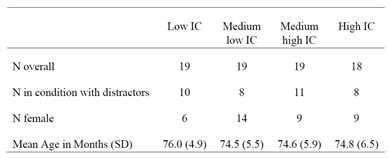 |
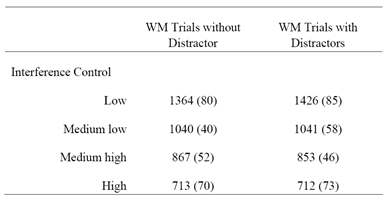 |
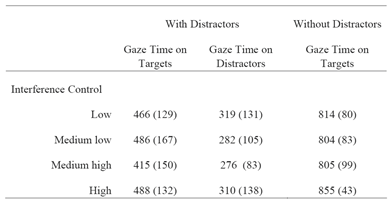 |
Copyright © 2010. This article is licensed under a Creative Commons Attribution 4.0 International License.
Share and Cite
Roebers, C.M.; Schmid, C.; Roderer, T. The Contribution of Interference Control for Young Children's Working Memory Performance: Insights from Eye-Tracking. J. Eye Mov. Res. 2009, 3, 1-10. https://doi.org/10.16910/jemr.3.5.4
Roebers CM, Schmid C, Roderer T. The Contribution of Interference Control for Young Children's Working Memory Performance: Insights from Eye-Tracking. Journal of Eye Movement Research. 2009; 3(5):1-10. https://doi.org/10.16910/jemr.3.5.4
Chicago/Turabian StyleRoebers, Claudia M., Corinne Schmid, and Thomas Roderer. 2009. "The Contribution of Interference Control for Young Children's Working Memory Performance: Insights from Eye-Tracking" Journal of Eye Movement Research 3, no. 5: 1-10. https://doi.org/10.16910/jemr.3.5.4
APA StyleRoebers, C. M., Schmid, C., & Roderer, T. (2009). The Contribution of Interference Control for Young Children's Working Memory Performance: Insights from Eye-Tracking. Journal of Eye Movement Research, 3(5), 1-10. https://doi.org/10.16910/jemr.3.5.4



